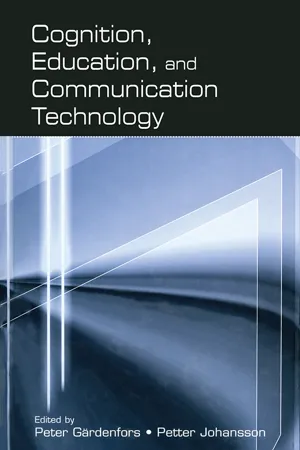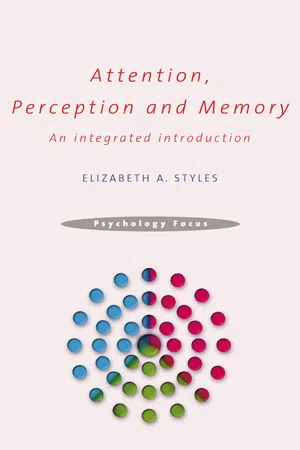Image Representation
Image representation refers to the methods used to store and manipulate visual data in a digital format. It involves converting images into a form that can be processed by computers, often using pixels to represent color and intensity. Common image representations include bitmap, vector, and digital signal processing techniques.
3 Key excerpts on "Image Representation"
- eBook - ePub
Cerebellum and Cerebrum in Homeostatic Control and Cognition
A Systems Approach to an Integrated Psychology
- Eric Parkins(Author)
- 2021(Publication Date)
- Routledge(Publisher)
...Chapter 2 Cognition as information representation and processing DOI: 10.4324/9781003024606-3 The representation of information The representation of knowledge is considered to be a central issue in artificial intelligence, cognitive science, and psychology (Denis, 1991 ; Holyoak, 2004 ; Pylyshyn, 1991 ; Sun, 2016). Information may be systematically represented in different forms, and within fundamentally different representational forms, information will be organised and processed (computed) in fundamentally different ways (Hayes, 1985 ; Sloman, 1985 ; Sun, 2016). Certain information may be accommodated naturally and easily by one form of representation, whereas the same kind of information may be difficult or even impossible to accommodate in another form of representation (Kendon et al., 2015b ; Reichgelt, 1991 ; Woods, 1987). Different forms of representation/processing may therefore be best suited to performing different tasks and serving different purposes (Chandrasekaran, 1987 ; Sloman, 1985, 1996). Ultimately, the information representation characteristics of a learning-based system will determine – and limit – what can be perceived, and known or understood; the manner in which the external world can be evaluated; and the kind of action that can be taken on the basis thereof (Peschl, 1997 ; Sun, 2016 ; Woods, 1987). Different forms or systems of representation and processing of information in AI Within AI, two categorically different forms of information representation and processing are recognised. The first category includes parallel, connectionist, associative, analog, or similarity based, whilst the second AI category includes digital, serial, abstract symbolic, or rule based (Funt, 1980 ; Kendon et al., 2015b ; Mackay, 1949 ; Pastur-Romay et al., 2017 ; Sloman, 1975 ; Sun, 2016). One fundamental difference between the two categories is the speed of processing (Kendon et al., 2015b)...
- PETER GARDENFORS, Petter Johansson, PETER GARDENFORS, Petter Johansson(Authors)
- 2014(Publication Date)
- Routledge(Publisher)
...This position seems even more important to consider in present-day society with an increasing exposure to new media and the new modes of representation that are introduced, for instance, through the use of computers in instructional settings. For, as suggested by Healy and Hoyles (1999) and many others, something interesting has happened to visual representations as they have become integrated with digital technology: Images now can be externalized through computer constructions, rendering more explicit previously hidden properties and structures. A visual image can be made open to inspection, an object of reflection, which can serve as a building block in an argument—something more concrete rather than transitory and fleeting. Once constructed on the computer, images are manipulable: They can be debugged, reconstructed, transformed, separated or combined together, following sets of procedures with something like the reproducibility and rigor previously limited to symbolic representation. (Healy & Hoyles, 1999, p. 59) Healy and Hoyles (1999) further argued that given these developments, the role of visual representations in schools must be explored to reach a better understanding of the potentials of the new media and technologies for teaching and learning. It should also be pointed out that researchers, as well as educators, need to know more about how children relate such pictorial and graphic displays and how they manage to incorporate these into their argumentation when “talking science” (Lemke, 1990). This is the issue we explore. Research Design This work should be seen as exploratory. It connects to the earlier research (Schoultz et al., 2001, Ivarsson et al., 2002) mentioned previously about children’s understanding of gravity and the shape of the earth through the interest in studying the tool-dependent nature of human cognition and communication...
- eBook - ePub
Attention, Perception and Memory
An Integrated Introduction
- Elizabeth Styles(Author)
- 2004(Publication Date)
- Psychology Press(Publisher)
...Although we mentioned some aspects of the way this knowledge was coded, we must now tackle the problem in more detail. Some questions that need answering are ‘What is a representation?’; ‘Are there different kinds of representation?’ and ‘How is knowledge organised?’. We shall take these in turn. What is a representation? Basically, a representation is something that stands for something else. The represent ation is responsible for represent ing in the brain the object or situation in the world that is represen ted. The represent ation can be considered as a mapping between what is doing the represen ting and what is represent ed. For example, the word ‘cup’ is a represent a-tion that maps between the object that is represent ed and the cognitive system that is represent ing it. The word cup is a ‘symbol’ for the object, it bears no relationship to the visual properties of a cup, but is used to represent it. On the other hand, a picture of a cup is analogous to the real object. Are there different kinds of representation? There are obviously a number of different ways for representing the same information in the external world. For example, imagine the pattern spots on a dice that has fallen to show ‘three’. The word three represents the number of spots, but the pattern of dots could be represented as the numerical symbol 3, or as a spatial image, or as a verbal description such as ‘the black spots form a diagonal line from the top left to the bottom right’. However, the fact that we can describe the information on a dice in different ways does not tell how the cognitive system represents that information. It is possible that the information is represented in one form only, but the cognitive system is able to interpret it in different ways. If we consider semantic knowledge, for example ‘some animals are birds’, ‘birds can fly’, ‘canaries sing’, it is difficult to think of many different ways of representing this knowledge...


